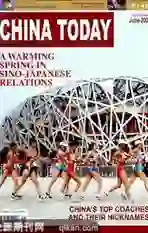Sci-tech Info
2008-06-25
Preliminary Research for Chinas Sun Praobe Complete

Chinas space program is set for another first. “Preliminary research is complete for the ‘Kuafu Project to probe the sun,” said Xiao Zuo, professor at the School of Earth and Space Sciences at Peking University. The mission involves three satellites -- Kuafu A and Kuafu B1 and B2 that will perform uninterrupted observation of heliospheric activities and their geo-effects. Kuafu A will be located at the Lagrangian point L1, the area of gravitational equilibrium between the Earth and the Sun, and the two Kuafu-B satellites will travel in identical elliptical polar orbits, relatively phased so that one is at its perigee while the other is at its apogee.
The Lagrangian point is 1.5 million kilometers from the Earth. Until now, only the United States has succeeded in stationing a solar observation platform there. However, the Chinese mission differs in that the Kuafu will be the worlds first space weather observatory system capable of continuous observation of the Earth-Sun environment as an interactive system, and will be able to measure precisely the energy transfers of geo-effects, such as geomagnetic storms.
Chloroplast to Generate Power
Mans dream of an abundant source of clean energy may soon be fulfilled by an ancient process -- plant photosynthesis. Researchers at East China Normal University have successfully recreated chloroplast using nano-materials, and they have been able to generate electricity for a fraction of the cost of conventional solar cells.
The innovative battery mimics the structure of chloroplast, with a special light-sensitive dye on the nanometer sandwiched in the cell, and a titanium dioxide component to convert light into electricity. The cellss photoelectric conversion efficiency has now reached 11 percent, the highest in the world, and it enjoys a significant advantage in price and simplicity. The cost of the dye-sensitized solar cell is just one-tenth that of a silicon cell, nor does it require much light, making it ideal for indoor use. Scientists are now studying how to extend the cells working life.
New Treatment for Septic Shock Found
Researchers at the Shanghai Life Science Research Institute at the Chinese Academy of Sciences have discovered a crucial molecule regulating the human immune system, and the find may provide a new treatment for Septemia, a potentially deadly condition.
Septic shock is caused by an infection of the bloodstream, which causes the Toll-like receptor (TLR) signal pathway of the human immune response system to overcompensate, producing excess cytokines that lead to inflammation, shock, and often death.
Based on guinea pig shock model studies, the institutes scientists have discovered that the TLR signal pathway -- the major septemia-related immune response signal -- can be dampened by using TRIM30, a molecule produced by the immune system at the onset of inflammation. When introduced into the system, it has been found to have a clear inhibitory effect on cytokines.
Biologically Degradable Material
for Clothing Approved
Polylactic acid fiber, which was developed by the Changchun Institute of Applied Chemistry, affiliated with the Chinese Academy of Sciences, has been formally recognized as a national sci-tech achievement. As a completely bio-degradable raw material, it promises to transform industries such as chemical fibers, textiles and clothing.
To make the fiber, researchers distilled a lactide monomer from a solution of lactic acid, obtained polylactic acid fluid after polymerization, and then spun the threads directly. Based on weaving and dyeing experiments, the filaments performance proved equal to that of polyester. With a current production of 50 tons per year, the product is both economical and energy efficient.
New Surveillance System Inaugurated
Chinas new wireless long-distance video monitoring system has been made operational in Hubei Province. The system comprises image gathering, video data processing and transmission, and image storage. It also features a portable terminal control center from which images can be transmitted wirelessly by CDMA or WiFi, freeing up the system from the limitations of local conditions. Currently in Hubei Province it is widely used in police work, firefighting, environmental protection, traffic and accident rescue.
Chinese Scientists Develop Nanometer
“Ordered Fiber”
Using a novel “electric spinning” technology, Chinese scientists have developed a nanometer fiber with a controllable pattern and weave structure, which can be used in clinical treatments as artificial vessels and bones.
After extensive experimentation and research, the Shanghai Silicate Research Institute, affiliated with the Chinese Academy of Sciences, discovered that the electric field force and the coulomb force play key roles in fiber sedimentation and arrangement. Consequently, they subtly designed the collective templates in various structures, and successfully made the fiber with a controllable pattern and weave structure. As a major advance in “electric spinning” technology, it has enormous potential for biomedical engineering applications, especially in the field of histology, and other industries.
Chinas Moon Rover Clears
All Obstacles
Chinas independently developed moon rover, which will be used during the second phase of the Change lunar probe program, is a genuine feat of engineering, capable of overcoming virtually any obstacle it is likely to encounter on its upcoming mission to explore the lunar surface. “The rover will unfold and stand on its wheels automatically before proceeding with its exploration tasks once it gets out of the spacecraft,” said Mao Ming, head of the China North Vehicle Research Institute, which is in charge of the rovers development.
Because the lunar surface is covered in a layer of soft dust, it has a low carrying capacity. Therefore, the vehicle has been fitted with reticular, or net-like, wheels to minimize weight and funnel the lunar soil away from the tires. Whatever obstacle the rover encounters, it will always make vertical contact with the ground. Even while moving on an uneven surface, it has a wheel clearance of 600 mm, and should it run across an obstructing rock, it will lift up its two front wheels and pass over it.
